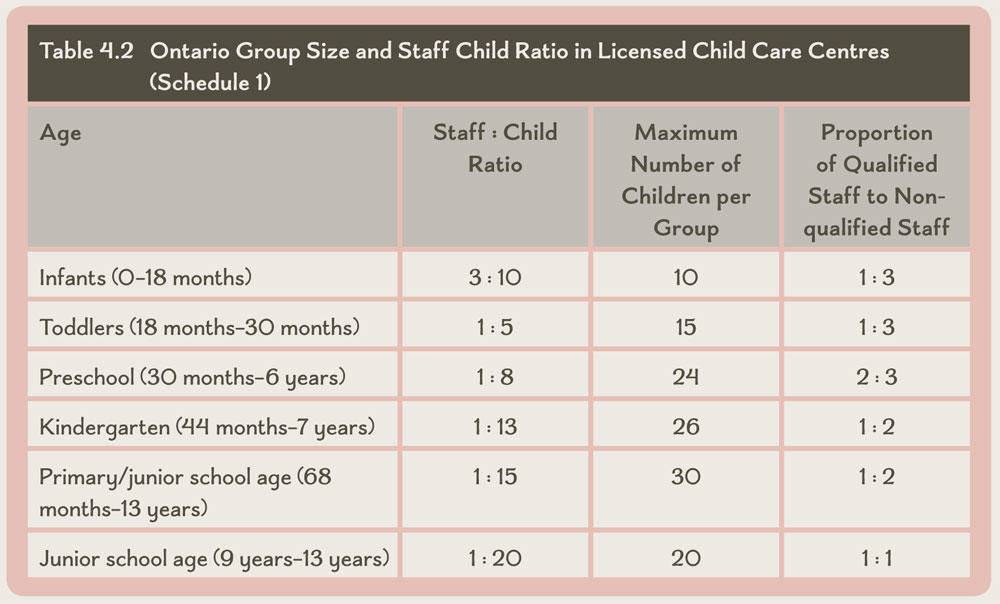6.1 Ratios

Regulation
Ratios and maximum group sizes, child care centre
8. (1) Every licensee shall ensure that in each child care centre it operates,
(a) the children are placed in groups according to the age categories set out in Schedule 1;
(b) every licensed age group includes only children whose age falls within the age category of the group, subject to subsection (2);
(c) for every licensed age group, the requirements set out in Schedule 1 that are applicable for the age group respecting,
(i) the ratio of employees to children,
(ii) the maximum number of children in the group, and
(iii) the proportion of employees that must be qualified employees,
are satisfied, whether children are on the premises or during activities off the premises, unless otherwise approved by a director. O. Reg. 126/16, s. 9 (3); O. Reg. 51/18, s. 7 (1, 2); O. Reg. 174/21, s. 6.
(Ontario Regulation 137/15, under the Child Care and Early Years Act, 2014. © King’s Printer for Ontario, 2015)

Early Childhood Education Report 2020. All Rights Reserved.
Educators must be in compliance with mandated ratios when working with children. The ratio of adults to children decreases as the age of children increases. Maximum group sizes ensure the quality of supervision is not decreased with too many children congregating in the same spaces. Program Advisors work with a formula to ensure enough square footage is available for the number of children in a designated space. Click the image to view the table.
Reduced Ratios
There are times throughout the day when ratios may be reduced to support staffing needs in toddler, preschool, and school age groupings. In full day programs the first 1.5 hours after a licensed child care facility opens ratios may operate at ⅔ of the mandated ratios. The same may occur in the last operational hour of each day. During times of rest up to a maximum of 2 hours, licensed settings may operate at ⅔ of the mandated ratios. This time is typically used for educators to take lunch breaks.
An exception may be made during rest periods if another approved employee is present in the building. Toddler and preschool programs may operate with a reduced ratio of ½ during a rest period up to a maximum of 2 hours if another approved employee is available in the event of an emergency. This may be a supervisor or support staff who can assist as needed if multiple children wake up early or an incident occurs. The reduced ratio of ½ during rest periods must be discussed with Program Advisors to ensure the license accommodates this practice.
Infant programs must never run with reduced ratios at any time during operational hours. Additional staffing may be required to ensure educators in infant programs have lunch breaks and are relieved at the end of their shifts. Another time when mandated ratios must never be reduced occurs during outdoor time. Risks often increase during outdoor play so mandated ratios must be adhered to at all times during outdoor play.
Licensees must assess whether reduced ratios are effective to support staffing when the needs of a group may be higher than usual. Often arrival and departure times are busy with educators and families interacting. These times typically coincide with reduced ratios so it is pertinent to track the numbers of children present in the first 1. 5 hours of the day and the last 1 hour of daily operations. Additional staffing may be required to adhere to regular mandated ratios for safe supervision of children.
Regulation
Ratios and maximum group sizes, child care centre (continued)
8. (4) Despite subsections (1) and (3), the ratio of employees to children for a licensed age group may be reduced to less than that required under those subsections, in accordance with the following:
- The reduced ratio shall not be less than two-thirds of the required ratio.
- Subject to paragraphs 4 and 5, the reduced ratio may be in effect only during the periods of arrival and departure of children and during the rest period.
- For the purposes of paragraph 2, the periods of arrival and departure are, i. for a child care centre that has a program that runs for six hours or more in a day, the 90- minute period after the program starts each day and the 60-minute period before the program ends each day; and ii. for a child care centre that has a program that runs for less than six hours a day, the 30- minute period after the program starts each day and the 30 –minute period before the program ends each day. The reduced ratio shall not apply during outdoor play periods.
- The reduced ratio shall not apply at any time in respect of a licensed infant group.
- The reduced ratio shall not apply during outdoor play periods.
(Ontario Regulation 137/15, under the Child Care and Early Years Act, 2014. © King’s Printer for Ontario, 2015)
Enhanced Ratios
Additional funding may be available to enhance inclusive practice in learning spaces. As discussed in chapter four, licensed child care settings collaborate with Resource Consultants to support the inclusion of all children in learning spaces. A small amount of funding may be allocated to enhance ratios with a program assistant. This role is intended to be an extra support in a classroom and doesn’t work one on one with a particular child. This role is not counted in the mandated ratios so must accompany an educator and group of children, rather than be counted in ratio.

